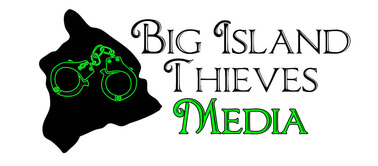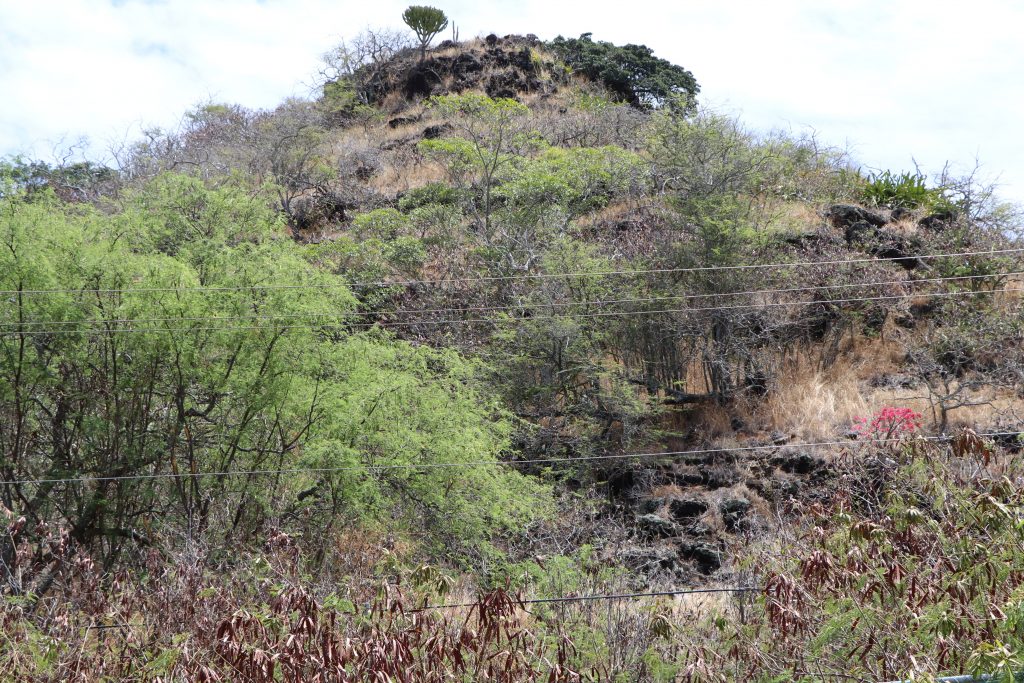If you go back and listen to the sound of a small wildfire just last week, you hear how tinder dry the forest is. Snap, crackle, pop. If you listen to radio and television announcements, we’re all being asked to conserve water. The link between drought conditions and wildfire in Hawai‘i is already in full play and conditions this summer are expected to worsen.
This is the message of the annual Wildfire & Drought LOOKOUT! awareness campaign, hosted by the Hawai‘i Wildfire Management Organization (HWMO). It is a collaborative effort of dozens of wildfire and water management organizations and agencies statewide to provide wildfire and drought preparedness tips.
Today, at a news conference held in the Mariner’s Cove/Kamilo Nui community, a meteorologist, a fire scientist, a fire manager, and a fire inspector shared current and predicted Hawai‘i drought conditions, the seasonal fire outlook, and what everyone can do to prevent wildland fires.
Meteorologist Derek Wroe, of the National Weather Service Honolulu Forecast Office said,
“Recent rainfall has provided some benefit for leeward Kaua‘i and O‘ahu, but moderate to extreme drought covers large portions of O‘ahu, Maui County, and the Big Island. As people know, we are heading into the hotter and drier summer months, and projections call for rainfall to be below normal. As a result, drought will likely expand and worsen over the fire prone leeward areas. These drier than normal conditions may linger into the beginning of the normal wet season in October and November.”
The U.S. Drought Monitor is showing more than a half million of us are already being impacted by drought conditions.”
The drought monitor, tracks conditions weekly and data released on June 2, shows areas of extreme drought on Moloka‘i, Kaho‘olawe, Maui, and Hawai‘i Island. Only Kaua‘i is currently drought free.
“As people know, we’re heading into the much dryer, hotter summer months, so there’s no reason to expect any relief from the drought. We do expect the percentage of land in the extreme to exceptional drought categories to grow,” Wroe added.
Dr. Clay Trauernicht is an Ecosystems and Fire Extension Specialist at the University of Hawai‘i
Dept. of Natural Resources and Environmental Management, who studies the impacts of fires on natural systems.
“Most wildfires in Hawai‘i tend to be smaller in size when compared with other western states. However, most years, as a percentage of land area, Hawai‘i loses as much acreage to fire as all the large states on the West Coast and in the Western U.S. Fortunately, there is a lot we can do to protect our people and places from wildfire. We just all need to take preparedness action,” Trauernicht said.
Drought and wildfire conditions were evident from last week’s three-acre Kuaokalā Guarantee Fire on O‘ahu. It burned hot and fast before wildland firefighters from the DLNR Division of Forestry and Wildlife (DOFAW) put it out.
DOFAW State Wildfire Manager Mike Walker said the fire likely sparked from a roadside, unattended campfire. “In this same area we’ve had four or more fire starts from unextinguished campfires. This forest and many others around the state are bone dry and getting dryer by the day,” he explained.
Forest users are reminded that ground fires are always strictly prohibited on lands managed by DOFAW, which include State Forest Reserves and Natural Area Reserves. Campfires must be in a container such as in a barbeque grill or metal drum. All embers must be extinguished when the fire is unattended. “We recommend campers and hikers carry extra water and fire extinguishers in their vehicles when in forested or vegetated areas, especially during dry, windy summer months,” Walker added.
Walker noted that while DOFAW has primary fire suppression responsibility on State lands under its jurisdiction, initial response and firefighting is often shared with county fire departments.
Today’s news conference was held in the Mariners Cove/Kamilo Nui community in East O‘ahu to highlight the neighborhood’s national recognition as a Firewise USA® community and its ongoing participation in the Hawaiʻi-Firewise program led by HWMO in partnership with DOFAW.
Honolulu Fire Dept.(HFD) Inspector Carl Otsuka commended community members for instituting many of the protective steps, outlined by HFD and HWMO through the Hawaiʻi-Firewise program. “To protect their properties and their community they’ve created fire breaks near structures, are keeping their rain gutters clear of debris and keeping trees and vegetation cut-back,” Otsuka commented.
Another linkage between drought and fire, noted by Otsuka, is all the water from municipal fire hydrants is potable water. The more firefighters need, the less drinking water will be available which could lead to non-voluntary water restrictions if drought conditions worsen. # # #

